
International Association of Double Star Observers (IADSO)
The International Association of Double Star Observers is a group of people around the world who are dedicated to promoting the scientific research of double stars.
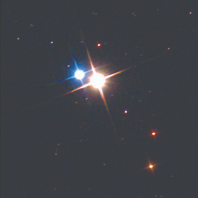
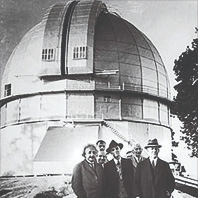
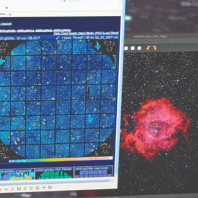
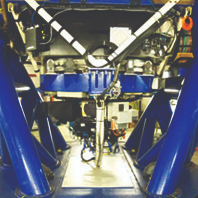
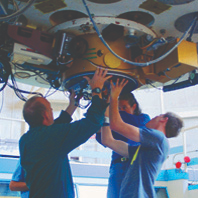
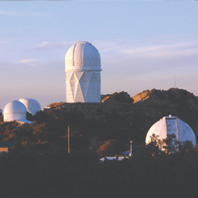
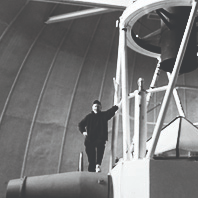
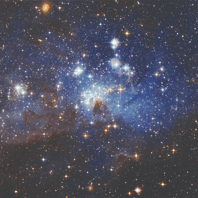
ABOUT
MISSION /
The International Association of Double Star Observers (IADSO) promotes the science of double and multiple stars through astrometric, photometric, and spectroscopic observations, the identification of physically bound or projected pairs, the determination and refinement of binary star orbits, and the publication of these observations and analysis in recognized scientific journals. The IADSO encourages all forms of quantitative, publishable, double as well as multiple star observations. These include observations made with visual astrometric eyepieces, filar micrometers, and CCD cameras, as well as speckle interferometry, high speed occultation photometry, and high resolution spectroscopy. The IADSO fosters improvements in the accuracy and efficiency of observations, and works to make instrumentation and software practical and affordable for smaller observatories.
INVOLVEMENT /
The IADSO provides an international forum for the communication of ideas, observations, discoveries, observing techniques, instrumentation, and software by initiating conferences and workshops, hosting the IADSO web site, publishing books, raising money for student research scholarships, and connecting experienced double star mentors with beginning student and amateur researchers. The IADSO is grateful to Alt-Az Initiative for hosting IADSO’s web site, the Collins Foundation Press for publishing the IADSO’s first book, The Double Star Reader, the University of Hawaii’s Institute for Astronomy for hosting the IADSO’s first conference, and the non-profit Collins Educational Foundation for conference management and handling tax-deductible donations for student scholarships.
CONNECTION /
IADSO-organized meetings and conferences allow professional and amateur astronomers, as well as educators and students, to communicate on a face-to-face basis, foster new ideas, forge new relationships, and promote international collaboration. The IADSO encourages its members to publish their findings in the many excellent double star journals such as El Observador de Estrellas Dobles, Web Deep Sky Society, Il Bolettino delle Stelle Doppie, and the Journal of Double Star Observations.
PEOPLE /
Several areas of observational astronomy, including variable stars and double stars, are amenable to making useful, published contributions to science with relatively modest instrumentation and skills. Undergraduate students and even high school students, through published and subsequently cataloged observations of double stars, not only have contributed to science, but have significantly increased their understanding and appreciation of science as well as advancing their educational careers. The IADSO encourages and supports student double star research. Anyone interested in double star research can become a member.
MEMBERSHIP
WHO WE ARE /
Everyone, world-wide—professional and amateur astronomers, students and educators—with an interest in promoting the science of double star astrometry is invited to join the IADSO as a charter member.
JOIN THE DISCUSSION/
We have a Yahoo discussion group where you can subscribe to receive e-mails following discussions on double star research. You can also start your own discussion or respond to others’ posts. Visit the IADSO discussion group to learn more.
BECOME A MEMBER /
Members receive a charter membership certificate, the IADSO Newsletter, and notification of IADSO conferences, workshops, and books. There are no membership fees, although tax deductible donations through the Collins Educational Foundation (CEF) are welcome to support student scholarships and activities. To join, simply fill out this form and allow a few weeks for your certificate to be printed and mailed to you.
LIST OF MEMBERS /
David Rowe / PlaneWave Instruments
John Pye / University of Maui College
Stephen McGaughey / Haleakala Amateur Astronomers
Joseph Carro / Cuesta College
Thomas G. Frey / California Polytechnic State University
Russell M. Genet / California Polytechnic State University
David Dunham / International Occultation Timing Association
R. Kent Clark / University of South Alabama
Ed Wiley / Yankee Tank Creek Observatory
Vera Wallen / Central Coast Astronomical Society
Paul Hardersen / University of North Dakota
B.J. Fulton / University of Hawaii
CONTACT
WE ARE HAPPY TO ADDRESS ALL QUESTIONS AND COMMENTS!
Please send all comments and questions to our Corresponding Secretary, Russ Genet at russmgenet@aol.com or fill out the following form.
EVENTS
AUGUST 2025 / HONOLULU, HI, US
INTERNATIONAL ASTRONOMICAL UNION (IAU) GENERAL ASSEMBLY

Potential special meeting on double stars
OCTOBER 2024 / FLAGSTAFF, AZ, US
LOWELL OBSERVATORY RUN
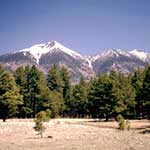
Gerard van Belle
Russ Genet, Cal Poly State University / russmgenet@aol.com
JULY 25-26, 2024 / SPRINGFIELD, VT, US
HARTNESS HOUSE DOUBLE STAR WORKSHOP
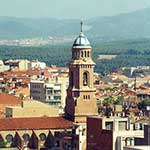
This workshop will be a part of the Stellafane Convention
CONTACT
John Briggs / john.w.briggs@gmail.com
or visit the convention website
MAY 2024 / KITT PEAK, AZ, US
2ND OBSERVING RUN AT KITT PEAK NATIONAL OBSERVATORY

Tentatively planned for May 2024 (bright time)

JANUARY 30-FEBRUARY 5, 2024 / MAUI, HI, US
MAUI 2024 DOUBLE STAR WORKSHOP
DECEMBER 7, 2023 / SAN LUIS OBISPO, CA, US
AMERICAN ALLIANCE FOR DOUBLE STAR RESEARCH (AADSR) CAL POLY WORKSHOP
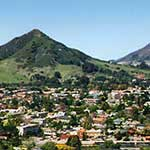
Dr. Russ Genet, Cal Poly State University / russmgenet@aol.com
NOVEMBER 21, 2023 / IRVINE, CA, US
EVENING TALK ON DOUBLE STARS
EVENT DESCRIPTION
Informal Workshop preceding the talk with speaker Russ Genet

Dr. John Kenney, Chair of Department of Physics and Astronomy at Concordia University / john.kenney@cui.edu
OCTOBER 15-23, 2023 / KITT PEAK, AZ, US
OBSERVING RUN AT KITT PEAK NATIONAL OBSERVATORY
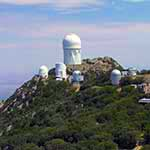
Dr. Russ Genet, Cal Poly State University / russmgenet@aol.com
OCTOBER 3-6, 2023 / LAKE SAN ANTONIO, CA, US
CAL STAR OBSERVING SESSION

First Light Portable 1.5-meter telescope
AUGUST 2, 2023 / MOUNT HOPKINS & SONOITA, AZ, US
VISIT TO FAIRBORN OBSERVATORY & WINER OBSERVATORY
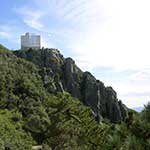
JULY 31, 2023 / KITT PEAK AZ, US
KITT PEAK ENGINEERING CHECKOUT
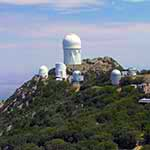
JULY 26-28, 2023 / PORTLAND, OR, US
PORTLAND VII ALT-AZ INITIATIVE WORKSHOP

JULY 23, 2023 / SAN LUIS OBISPO, CA, US
FOUNDING MEETING OF THE AMERICAN ALLIANCE FOR DOUBLE STAR RESEARCH (AADSR)
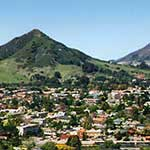
Held at California Polytechnic State University (Cal Poly)
JULY 19-21, 2023 / LOS ANGELES, CA, US
MOUNT WILSON DOUBLE STAR WORKSHOP

JULY 13-14, 2023 / APPLE VALLEY, CA, US
APPLE VALLEY WORKSHOP

MAY 21-23, 2023 / BIG BEAR, CA, US
SOCIETY FOR ASTRONOMICAL SCIENCES 32ND ANNUAL SYMPOSIUM
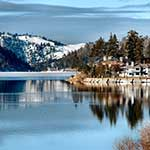
APRIL 1-3 / MOJAVE DESERT PRESERVE, CA, US
PINTO VALLEY OBSERVATORY 2ND OBSERVING RUN
FEBRUARY 8-10, 2023 / MAUI, HI, US
MAUI INTERNATIONAL DOUBLE STAR CONFERENCE

Held by the University of Hawaii’s Institute for Astronomy in Pukalani, Maui, Hawaii
DECEMBER 1-2, 2022 / KITT PEAK, AZ, US
OBSERVING RUN AT KITT PEAK NATIONAL OBSERVATORY
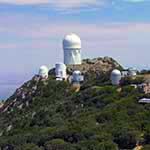
A 3.5-meter Wiyn Telescope was used on this run
MAY 23-25, 2022/ BIG BEAR, CA, US
SOCIETY FOR ASTRONOMICAL SCIENCES 31ST ANNUAL SYMPOSIUM
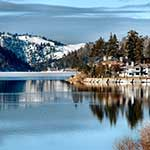
SOCIETIES
The Journal of Double Star Observations
A quarterly journal of amateur astronomy dedicated to the study of double and binary stars
The Webb Deep-Sky Society (Double Star Section)
An amateur/professional society specializing in double stars and ‘deep sky’ objects. There is also a direct link to the Webb Deep-Sky Society Circulars.
Pleine-lune.org
A French website providing a full lunar calendar : full moon, new moon and all the other phases of the moon.
Also scientific explanantions of moon and solar eclipses…
Astronomical Society of Southern Africa
Another fine society for amateur double star observers
The "Spirit of 33"
An international network of amateur double star observers, based in Spain
The Double Star Section of LIADA
The Spanish American League of Astronomy
The Double Star Club of the Astronomical League
An association of local amateur astronomical societies across the United States
Garraf Astronomical Observatory
Located near Barcelona, Spain and headed by Tofol Tobal, this organization has published over 10,000 visual double star observations in its “OAG General Catalog”
El Observador de Estrellas Dobles
A Spanish language electronic double star journal begun in 2009
Il Bollettino delle Stelle Doppie
A new Italian language electronic double star journal begun in April 2022
Washington Double Star Catalog (WDS) / The world’s principal database of astrometric double and multiple star information, updated nightly. Mason, Wycoff, and Hartkopf, 2001.
"Neglected Doubles" Observing Lists / Lists of unconfirmed binaries and systems which have not been resolved for many years. A section of the Washington Double Star Catalog.
Fourth Catalog of Interferometric Measurements of Binary Stars / All published measures of binary and multiple star systems obtained by high-resolution techniques, updated frequently. Hartkopf, Mason, and McAlister, 2001.
Sixth Catalog of Orbits of Visual Binary Stars / Series of compilations of visual binary star orbits, updated frequently. Hartkopf and Mason, 2001.
Calibration Candidates / Lists of binaries which might be used for scale calibration purposes. A section of the Sixth Catalog of Orbits of Visual Binary Stars.
Catalog of Orbits and Ephemerides of Visual Double Stars / Docobo, Ling, Prieto, Costa, Costado, and Magdalena, 2001.
Multiple Star Catalog / Last update April 2010. Tokovinin 1997.
USNO Third Photometric Magnitude Difference Catalog / Updated nightly. Mason & Wycoff 2001.
USNO Catalog of Rectilinear Elements / Updated occasionally. Hartkopf & Mason 2011.
SIMBAD Astronomical Database / Provides basic data, cross-identifications, bibliography and measurements for astronomical objects outside the solar system. Can query by object name, coordinates and various criteria.
SIDONIe: Site Informatique des étoiles Doubles de Nice / A database that recovered all the measurements of a handwritten file at the Côte d’Azur Observatory and is updated with new observations.
The SAO/NASA Astrophysics Data System / A Digital Library portal for researchers in Astronomy and Physics, operated by the Smithsonian Astrophysical Observatory (SAO) under a NASA grant
Optical Long Baseline Interferometry News / A forum for scientists, engineers, and students who share an interest in long baseline stellar interferometry by NASA’s Jet Propulsion Laboratory.
NExScI: NASA Exoplanet Science Institute Headlines / The science operations and analysis center for NASA’s Exoplanet Exploration Program, which provides tools and archives for the exoplanet community.
NExScI: NASA Exoplanet Science Institute Headlines / The science operations and analysis center for NASA’s Exoplanet Exploration Program, which provides tools and archives for the exoplanet community.
The General Catalogue of Photometric Data / The GCPD is a comprehensive database of photometric data for more than 80 systems, and their references.
BOOKS
OBSERVING AND MEASURING VISUAL DOUBLE STARS
2ND EDITION, Edited by R. W. Argyle.
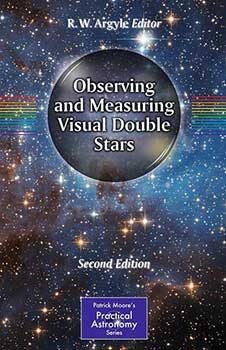
There are more binary stars visible in the night sky than there are single stars, and there are enormous numbers of wide, faint pairs under-observed or not observed at all—professional astronomers just don’t have the available time to study them. This is where amateur astronomers can help. Bob Argyle, a professional astronomer at Cambridge University, shows where enthusiastic amateur observers can best direct their efforts. The book caters for the use of every level of equipment, from simple commercial telescopes to micrometers and CCD cameras. Amateur astronomers who have gone beyond "sight-seeing” and want to make a genuine scientific contribution will find this a fascinating and rewarding field—and this book provides all the background and practical information that’s needed. Includes a free CDROM represents an informative snapshot of continually evolving catalogues, including; the United States Naval Observatory catalogues, the WDS, the Second Delta-m catalogue, the Fourth Interferometric catalogue and the Sixth orbital catalogue to be used in conjunction with the USNO website.
The second edition of Observing and Measuring Visual Double Stars contains a significant amount of completely new material inspired by the work done by observers since the first edition was published. Fifteen skilled and experienced astronomers have contributed chapters on their own specialization in the various fields. These include how to use the Internet to carry out precise astronomical measurement, an excellent guide to sketching double stars, and information on how to image double stars of unequal brightness. This new edition is the definitive book for those who are serous about this fascinating aspect of astronomy!
THE DOUBLE STAR READER: SELECTED PAPERS FROM THE JOURNAL OF DOUBLE STAR OBSERVATIONS
Edited by R. Kent Clark and Russell M. Genet.
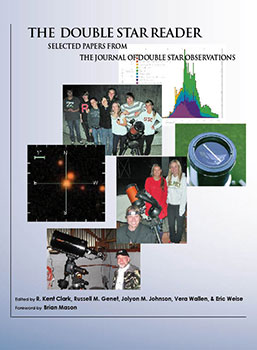
The majority of stars are gravitationally bound systems of two or more stars that are only distinguishable through a telescope. Their orbital periods range from days to millennia, often making double star research a multi-generational endeavor. Thus, astronomers today contribute measurements of systems that have been observed, in many cases, for centuries. Since the fundamentals of double star research are straight-forward and entry equipment is low cost, double star research is open to amateur and student astronomers. This book exposes the reader to a diverse sampling from the Journal of Double Star Observations detailing both historical and modern observations as well as the techniques and technologies used by amateurs, students, and professionals.
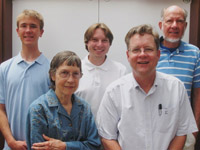
ABOUT THE EDITORS (LEFT TO RIGHT)
Eric Weise, Physics Major at University of California, San Diego
Vera Wallen, Educational Consultant and Retired Superintendent of Schools
Jolyon Johnson, Geologist and Science Director at the Orion Observatory
R. Kent Clark, Professor of Physics at University of South Alabama and Editor of the Journal of Double Star Observations
Russell Genet, Research Scholar in Residence at California Polytechnic State University and Adjunct Professor of Astronomy at Cuesta College.
LINKS
Washington Double Star Catalog (WDS)
The world’s principal database of astrometric double and multiple star information, updated nightly. Mason, Wycoff, and Hartkopf, 2001.
“Neglected Doubles” Observing Lists
Lists of unconfirmed binaries and systems which have not been resolved for many years. A section of the Washington Double Star Catalog.
Fourth Catalog of Interferometric Measurements of Binary Stars
All published measures of binary and multiple star systems obtained by high-resolution techniques, updated frequently. Hartkopf, Mason, and McAlister, 2001.
Sixth Catalog of Orbits of Visual Binary Stars
Series of compilations of visual binary star orbits, updated frequently. Hartkopf and Mason, 2001.
Calibration Candidates
Lists of binaries which might be used for scale calibration purposes. A section of the Sixth Catalog of Orbits of Visual Binary Stars.
Catalog of Orbits and Ephemerides of Visual Double Stars
Docobo, Ling, Prieto, Costa, Costado, and Magdalena, 2001.
Multiple Star Catalog
Last update April 2010. Tokovinin 1997.
USNO Third Photometric Magnitude Difference Catalog
Updated nightly. Mason & Wycoff 2001.
USNO Catalog of Rectilinear Elements
Updated occasionally. Hartkopf & Mason 2011.
SIMBAD Astronomical Database
Provides basic data, cross-identifications, bibliography and measurements for astronomical objects outside the solar system. Can query by object name, coordinates and various criteria.
SIDONIe: Site Informatique des étoiles Doubles de Nice
A database that recovered all the measurements of a handwritten file at the Côte d’Azur Observatory and is updated with new observations.
The SAO/NASA Astrophysics Data System
A Digital Library portal for researchers in Astronomy and Physics, operated by the Smithsonian Astrophysical Observatory (SAO) under a NASA grant
Optical Long Baseline Interferometry News
A forum for scientists, engineers, and students who share an interest in long baseline stellar interferometry by NASA’s Jet Propulsion Laboratory.
NExScI: NASA Exoplanet Science Institute Headlines
The science operations and analysis center for NASA’s Exoplanet Exploration Program, which provides tools and archives for the exoplanet community.
NExScI: NASA Exoplanet Science Institute Headlines
The science operations and analysis center for NASA’s Exoplanet Exploration Program, which provides tools and archives for the exoplanet community.
The General Catalogue of Photometric Data
The GCPD is a comprehensive database of photometric data for more than 80 systems, and their references.